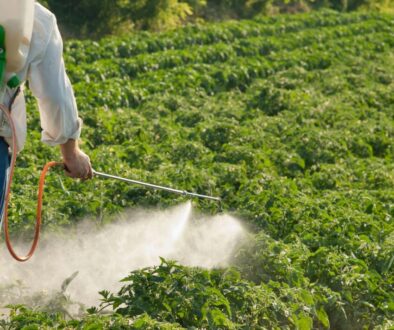Alarming levels of weed killer found in study of pregnant women
By Johnathan Hettinger and Carey Gillam
Pregnant women in a key US farm state are showing increasing amounts of a toxic weed killer in their urine, a rise that comes alongside climbing use of the chemicals in agriculture, according to a new study published Friday.
The study, led by the Indiana University School of Medicine, showed that 70% of pregnant women tested in Indiana between 2020 and 2022 had an herbicide called dicamba in their urine, up from 28% from a similar analysis for the period 2010-2012 that included women in Indiana, Illinois and Ohio.
Notably, the new study found that along with a larger percentage of women showing the presence of dicamba in their bodies, the concentrations of the weed killing chemical increased more than four-fold.
The study also looked for the presence of 2,4-dichlorophenoxyacetic acid, better known as 2,4-D, in the urine samples, finding that 100% of the women in both the earlier study and the new one had 2,4-D in their urine, with detectable, but not significant, increases in concentration levels.
The new findings add to a growing body of literature documenting human exposure to chemicals used in agriculture, and various known and potential health impacts. Many scientists have particular concerns about how farm chemicals impact pregnant women and their children, but say more research – and more regulatory scrutiny – is needed.
“These are two chemicals we’re concerned about because of their increasing use,” said Paul Winchester, a clinical professor of pediatrics at the Indiana University School of Medicine who was not involved in this study. Winchester is part of a related long-term study of the outcomes for women and their offspring exposed to dicamba and 2,4-D.
Winchester called the findings “sobering” and said that there is growing evidence that these chemicals can be harmful to unborn children.
“Fetal DNA is being shaped by these exposures,” he said. “What we’re seeing in other chemicals that have had longer pathways of study is that this is not benign exposure.”
Dicamba exposure has been linked to increased risk of liver and bile duct cancer. Some animal studies of 2,4-D exposure during pregnancy found low body weights and changes in behavior in the offspring, while other studies have found that exposure to 2,4-D appears to increase the risk of lymphoma.
Rising use
Several studies have sought to document the presence of the popular weed killer glyphosate in humans, including in pregnant women. Gestational exposure to glyphosate – the key ingredient in the well-known Roundup herbicide – is associated with reduced fetal growth and other fetal problems, and glyphosate separately has been linked to cancer and other health problems.
Monsanto introduced glyphosate to agriculture decades ago, followed by genetically engineered crops created to withstand glyphosate spray, allowing farmers to kill weeds in their fields without harming the crops. That GMO technology led to skyrocketing use of the weed killer starting in the late 1990s, but extensive and repeated use of glyphosate over glyphosate-tolerant crops backfired – triggering an explosion of glyphosate-resistant weeds.
Monsanto and other companies then developed dicamba-tolerant GMO crops and 2,4-D-tolerant crops that could also be sprayed directly with those chemicals. As a result, reliance on dicamba and 2,4-D has risen 10-fold compared to 2010, largely due to the weed resistance issues, and the launch of the new types of GMO crops.
The study notes that the vast majority of soybean and cotton seeds now sold and grown in the US are genetically engineered to tolerate being sprayed with a range of herbicides, including not just glyphosate but also dicamba and 2,4-D.
“There’s no other way to explain a four-fold increase in dicamba in the urine of pregnant women in the Midwest other than the planting of these technologies,” said Chuck Benbrook, a co-author of the study and an expert witness for some cancer patients who’ve sued Monsanto alleging Roundup caused their diseases. “This is a technology they probably should never have approved.”
Dicamba has particular volatility when sprayed on farm fields and is capable of traveling far from where it is sprayed, so exposure does not necessarily only occur on or near a farm where it is sprayed. Since dicamba-tolerant crops were introduced, the controversial weed killer has been documented on non-target crops, on trees miles from fields, even in rain.
Last week, a federal court in Arizona vacated the registrations of the weed killers, ruling that EPA violated the law in approving dicamba by not giving adequate opportunity for public comment. It was the second time a federal court has banned dicamba. But this week, the EPA said despite the court ruling it still will allow millions of gallons of dicamba to be sprayed this growing season.
“This is the kind of study where you’re not calling for more study, I’m saying it shouldn’t be in people’s bodies,” said Jennifer Sass, a senior scientist at NRDC. “This is the kind of study that says you guys need to do something about this — growers, companies and the EPA. Nowhere in the pesticide label does it say it should be in your body.”
Sass said that there are many unknowns about the health impacts of dicamba.
“We just don’t know much about dicamba. It’s not a clean slate, it’s a blank state,” Sass said. “We just don’t know much about its effects.”
Bayer, which purchased Monsanto in 2018, did not immediately respond to a request for comment.
A version of this story was co-published with The Guardian.




February 20, 2024 @ 2:47 am
Wenn keine Insekten vielmehr Bienen nicht mehr da sind 75 Prozent schon zurück gegangen sind wir Menschen auch nicht mehr da und das sollten alle Menschen weltweit mit beachten und dafür sich gegenseitig sich einsetzen das das nicht passiert bitte Danke